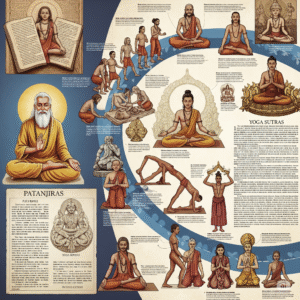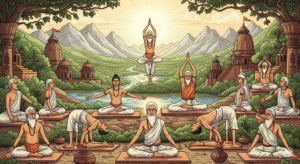Today we can see that people are practicing yoga everywhere whether it is gym, schools, at home etc. But have you ever thought about where it all began and why people are turning to yoga for all kinds of reasons? The history of yoga stretches back thousands of years, and understanding its roots adds a deeper dimension to every pose and breath we take.
Learning about the origin of yoga can help you connect more to practice it sincerely.
Also Read: benefits of yoga
Yoga Before Written History
The history of yoga or origin of yoga goes way back over 5,000 years ago. One of the earliest clues we have comes from the Indus Valley Civilization that is in Pakistan and north-west India. Archaeologists found ancient stone seals showing figures sitting in what look like meditative yoga postures. Although we can’t say for sure that those people were practicing the same yoga as we know it today, it’s an amazing glimpse into how early humans may have connected movement and meditation.
This period marks the symbolic origin of yoga, not just as a physical exercise but as a spiritual journey. Yoga back then was not likely just perfecting poses, but was likely about stillness, breath and inner awareness.
The Vedas and the Spiritual Roots of Yoga
Moving ahead to the Vedic period, around 1500 to 500 BCE, this was the time when the sacred Hindu texts called the Vedas were composed. These are among the oldest religious texts in the world. While they mostly focus on rituals and hymns, they also talk about practices that sound a lot like early forms of yoga like breath control, concentration, and deep thinking.
Later came the Upanishads, written between 800 and 400 BCE, which took these ideas to a deeper level. These texts started asking big spiritual questions like — Who am I? What is the soul? What is the purpose of life? They introduced the powerful idea that yoga could help connect the individual soul (Atman) with the universal soul (Brahman).
The history of yoga during this time laid the base for many of the spiritual and philosophical ideas that people still follow in yoga today.
Patanjali and the Eight Limbs
Around 200 BCE (some say a little before or after), sage Patanjali wrote the Yoga Sutras, a collection of 196 short verses that laid out a full path toward spiritual growth and self-realization. It was the turning point of yoga.
This became a big moment in the history of yoga. Patanjali didn’t just talk about yoga, he actually organised it into a proper system, which we now know as Rāja Yoga or Classical Yoga. He explained that yoga has eight limbs:
- Yama – moral values or how we behave with others
- Niyama – personal discipline and daily habits
- Asana – the physical postures we often practice today
- Pranayama – controlling the breath
- Pratyahara – turning our senses inward
- Dharana – deep focus or concentration
- Dhyana – meditation
- Samadhi – a state of spiritual bliss or enlightenment
What’s really interesting is that only one of these “asanas” is about the physical poses. The rest focus on the mind, the breath, and the inner self.
The Rise of Hatha Yoga, Mind and Body Unite
During the medieval period (around 800 to 1700 CE), Hatha Yoga came into the picture, giving more attention to the body as a way to grow spiritually. Ancient texts like the Hatha Yoga Pradipika and Gheranda Samhita were written during this time, and they explained in detail how to do different postures, control the breath, and cleanse the body.
Yoga in this period became more practical and physical. Yogis believed that by purifying the body and mastering the breath, they could awaken spiritual energy especially a powerful inner force called kundalini. Even though the goal was still spiritual, this form of yoga laid the base for the posture-based styles we see so much today.
You know the best thing is that Hatha yoga makes yoga easier to practice in daily life and you can do it wherever you want. Earlier sage used to practice it in caves or isolated places.
Yoga Reached the Modern Era
The modern chapter in the history of yoga started in the late 19th and early 20th century, when Indian spiritual leaders began travelling to the West to share yoga’s deeper meaning. One of the first was Swami Vivekananda, who gave a powerful speech at the Parliament of World Religions in Chicago in 1893. He introduced people in the West to the spiritual side of yoga, before yoga mats and studios were a thing.
Then, in the mid-1900s, teachers like T. Krishnamacharya, B.K.S. Iyengar, and Pattabhi Jois came along and shaped what we now know as modern yoga. Their students helped take yoga around the world bringing different styles like Iyengar Yoga, which focuses on alignment, and Ashtanga Yoga, a strong and flowing practice.
Thanks to these pioneers, the history of yoga moved into a new phase, one where East met West, and yoga became something people everywhere could relate to and practice.
Today, yoga is done by millions across the globe. While it’s often seen as a workout or a way to stay fit, many people are now going back to its roots looking into meditation, breathing, and the deeper meaning behind the poses.
Why the History of Yoga Matters
Yoga wasn’t invented to burn calories or tone muscles, it was born from a human longing for peace, clarity, and connection. Whether you’re doing sun salutations or sitting quietly in meditation, you’re participating in a tradition that has evolved over thousands of years.
